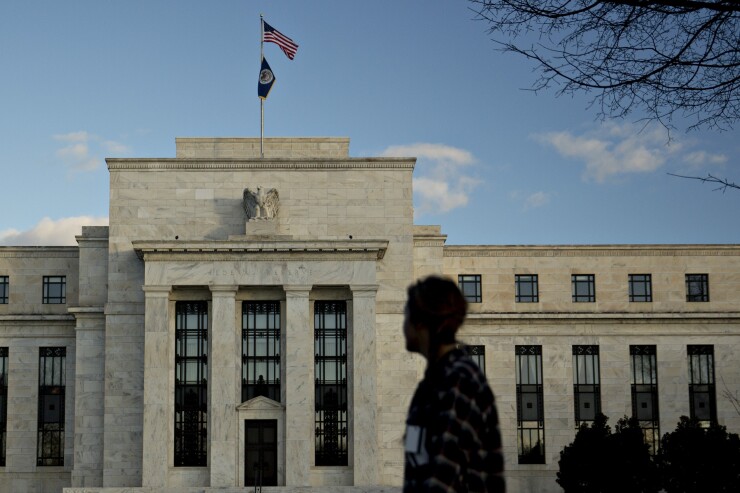(Bloomberg) — Federal Reserve policy makers left interest rates unchanged while saying the argument for higher borrowing costs strengthened further amid accelerating inflation, reinforcing expectations for a hike next month.
“The committee judges that the case for an increase in the federal funds rate has continued to strengthen but decided, for the time being, to wait for some further evidence of continued progress toward its objectives,” the Federal Open Market Committee said in a statement Wednesday following a two-day meeting in Washington.
Fed officials revealed growing confidence that inflation is on track to reach their 2% target. The central bank said Wednesday that the pace of price gains “has increased somewhat since earlier this year” and that market-based measures of inflation compensation “have moved up.” The committee also omitted previous language saying inflation would probably “remain low in the near term.”
The decision to forgo a rate increase had been widely expected owing to the proximity of next week’s U.S. presidential election and the lack of a scheduled press briefing after this meeting. Now the focus will shift to the FOMC’s gathering in December, provided the outlook for the economy and inflation isn’t thrown into doubt over the next six weeks.

This month’s statement said the Fed would wait for “some further evidence” of progress in the economy before raising rates, adding the qualifier “some” to language from September, a sign that officials moved incrementally closer to a hike.
TWO DISSENTERS
Cleveland Fed President Loretta Mester and Kansas City Fed chief Esther George, two of the three officials who dissented at the committee’s September session, repeated their objection, calling for raising the federal funds target by a quarter percentage point from its current range of 0.25% to 0.5%. The third, Boston Fed President Eric Rosengren, opted to support Wednesday’s decision to hold rates steady.
When leaving rates unchanged in September, the FOMC acknowledged the case for tightening policy had “strengthened.” Minutes of the session later showed that was a “close call” for several officials who supported the decision to stand pat and wait for the economy make more progress.
-
Arranging fixed income for periodic redemptions can deliver the risk/reward sweet spot.
June 30 -
The Federal Reserve chairwoman was mum about when there might be another hike, which for some suggests she's not in a hurry.
June 6
Investors weren’t convinced, however, that officials would pull the trigger this week. Pricing in federal funds futures contracts earlier Wednesday implied a roughly 15% probability of an increase at this meeting. Traders and economists instead had their eyes on the Dec. 13-14 meeting, when futures indicated a roughly two-in-three chance of a quarter-point move.
None of the 90 analysts surveyed by Bloomberg expected a hike this week.
In addition to the uncertainties for financial markets posed by the election, many Fed watchers have said the central bank is less inclined to alter policy at a meeting, such as this week’s, that doesn’t feature a scheduled press conference from Chairwoman Janet Yellen. The briefings follow alternating meetings.
INFLATION PICKUP
The Fed’s preferred gauge of price pressures has moved closer to the bank’s 2% target this year, reaching 1.7% in the 12 months through September after stripping out volatile food and energy components. Unemployment was 5% in September, at or close to what many economists estimate is its lowest sustainable level.
The central bank on Wednesday offered an assessment of the economy that was broadly similar to its September statement, reiterating that the “labor market has continued to strengthen and growth of economic activity has picked up” since the first half.
Officials acknowledged a cooling of consumer spending, saying it “has been rising moderately,” compared with September, when it had been “growing strongly.”
The economy expanded at a 2.9% annualized pace in the third quarter, according to a government report last week. While that was more than double the rate in the previous period, household spending actually slowed more than expected, while inventory rebuilding and a soybean-related jump in exports powered the rebound.
The Fed’s only rate increase since the financial crisis of 2008-09 came last December when officials lifted the target range by 0.25 percentage point. They have regularly signaled their expectation for additional, gradual increases, but were put off by a range of worries.
Concerns about slowing global growth early in 2016, a dismal U.S. employment report in May and the U.K.’s June vote to exit the European Union all helped delay potential rate hikes even as the U.S. economy continued on a broad trend of adding jobs and slightly higher inflation.





